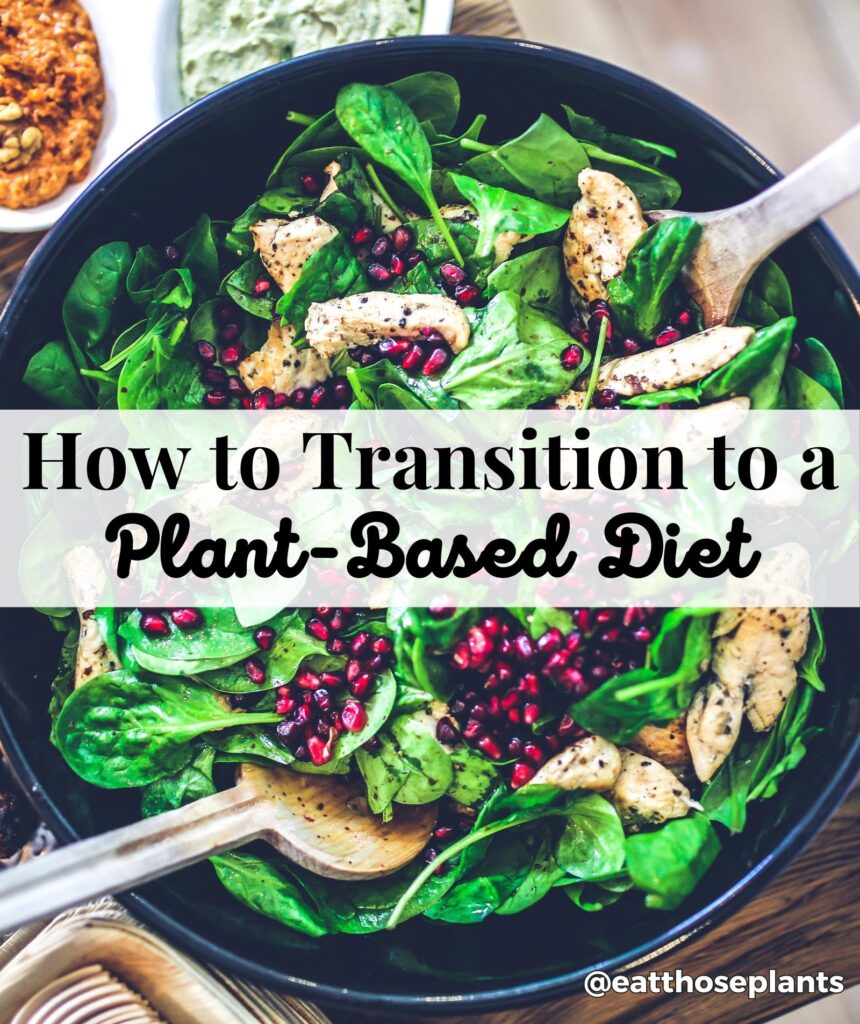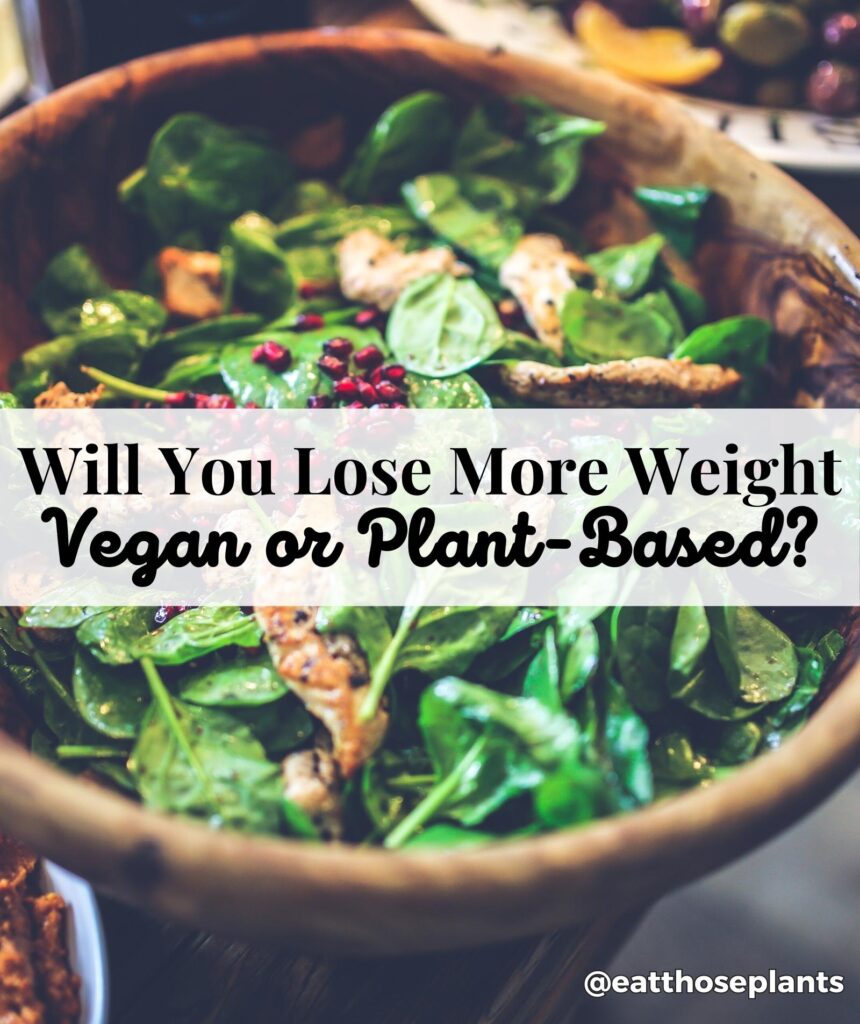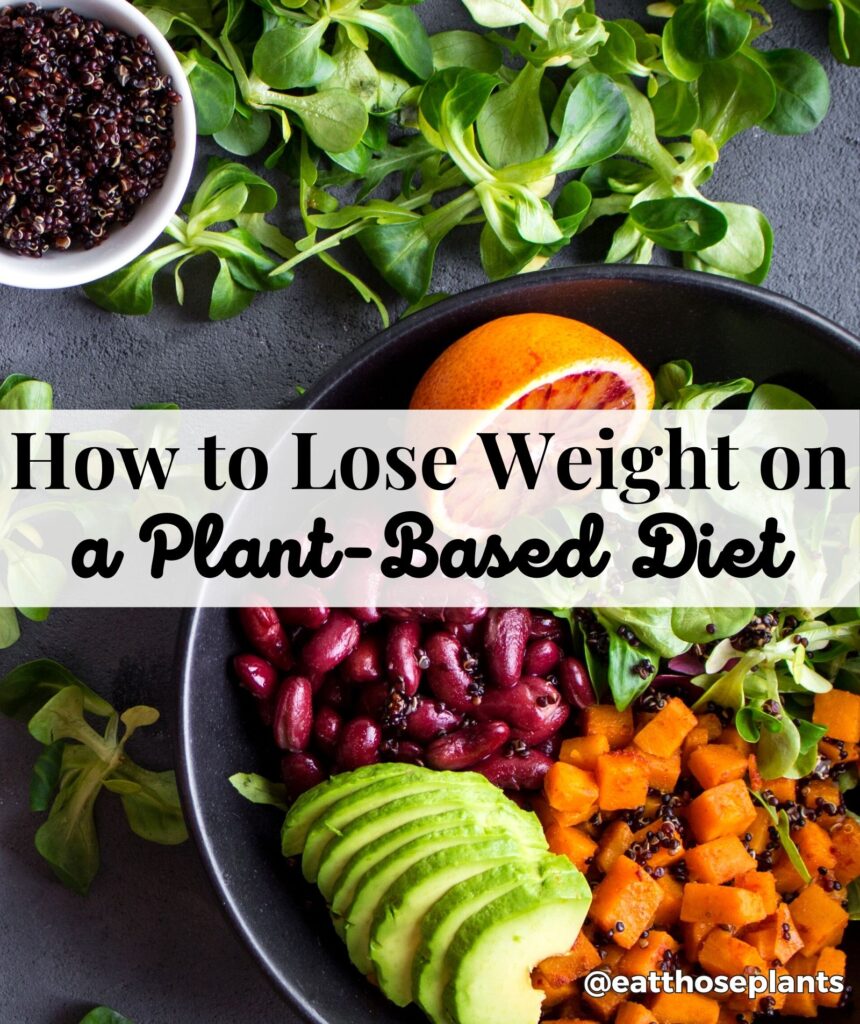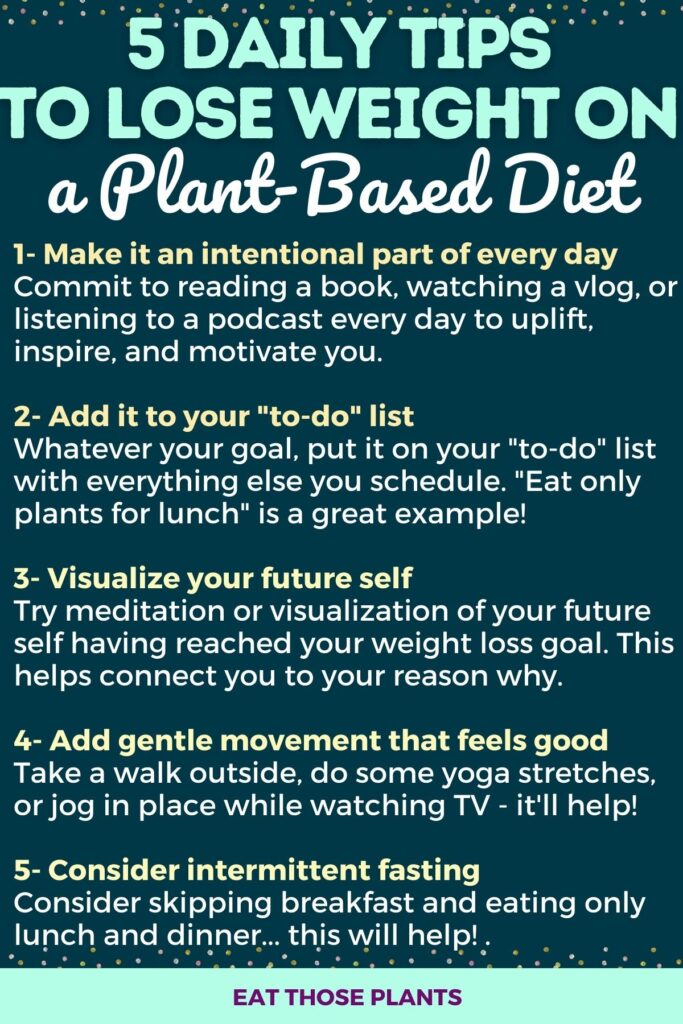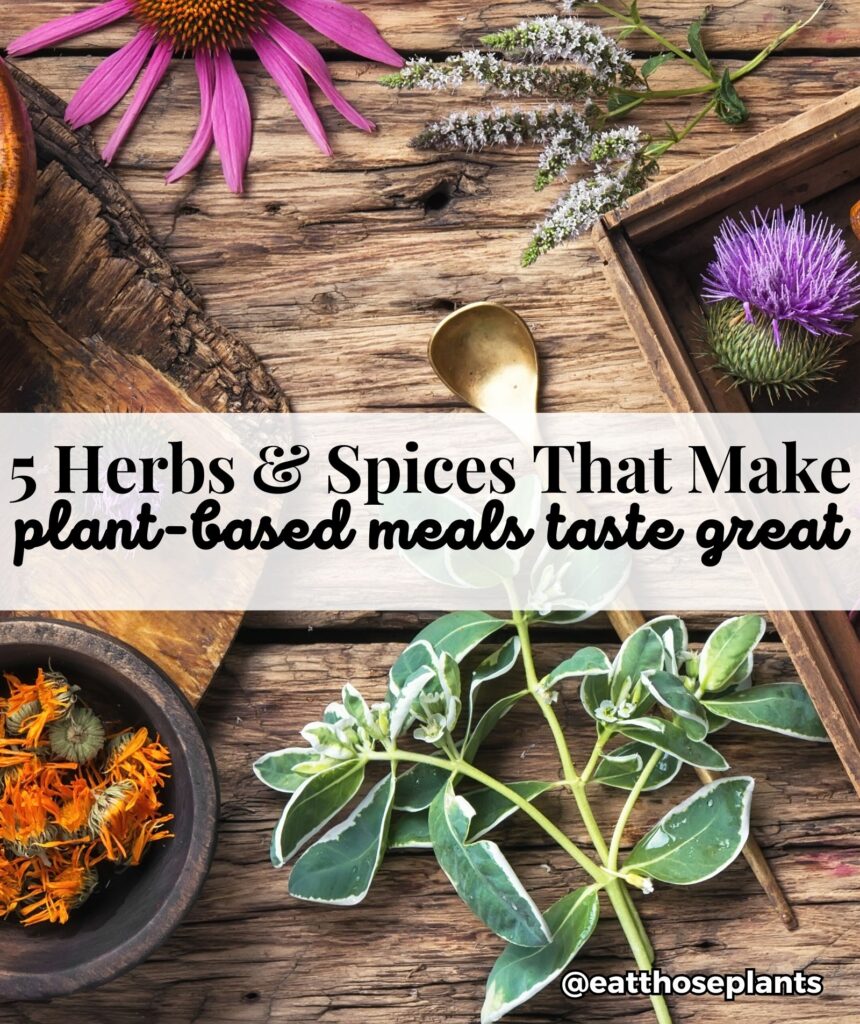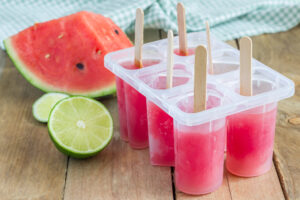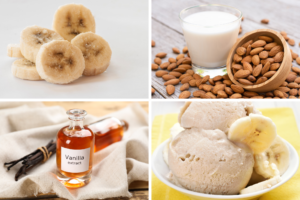There are so many benefits to including more plants in your diet, but of course, one of the best is for weight loss!
In this blog post, I’ll share my top tips for helping you gradually transition to a plant-based diet in a way that can help you release extra pounds, never go hungry, and actually enjoy the food on your plate!
What Is A Whole Food Plant-Based Diet?
A whole food plant-based diet (WFPB) is based on making choices that involve consuming minimally processed, unrefined foods.
As Dr. Michael Greger says, think of it simply as “nothing bad added, nothing good taken away.”
It’s pretty easy to consider what falls into that category when you think of it that way, isn’t it?
When you start to eat a whole food plant-based diet, you’ll be cutting out all meats and animal products in addition to any highly processed or refined carbohydrates such as sugar, white flour, or anything made with high fructose corn syrup.
But don’t think of it in terms of what you’re cutting out – you can add SO many colorful, flavorful, filling foods and spices to your plate.
If you play your cards right you’ll discover a whole world full of flavor and satisfaction – and I’m going to show you how!
What Is The Difference Between Vegan and Plant-Based?
Sometimes, “vegan” and “plant-based” are used interchangeably. While they do share some similarities, they are not the same thing.
A vegan diet excludes all animal products, which include meats, dairy, and eggs. Veganism is also an ethical position, however.
Therefore, in addition to abstaining from animal-based food products, vegans will also avoid all products tested on or made from animals (like household cleaners or makeup brands that have been tested on animals, or leather purses and shoes.)
A plant-based diet, on the other hand, has nothing to do with animal welfare, other than you don’t eat them or anything that comes from them – mostly for your own personal benefit.
Another important distinction between vegan and plant-based is that if you’re interested in improving your sense of well-being and losing weight, vegan may not necessarily be the best option for you.
There are so many highly-processed, highly caloric (yet delicious!) vegan foods that can trip you up if you’re not careful!
So going more plant-based you’ll most likely lose more weight and feel better than if you adopt a vegan diet that isn’t plant-based…
But you have to start somewhere (and I’ve never met an Impossible Burger that I didn’t like) – so you can still enjoy some of those foods some of the time and meet your weight loss goals (which is fantastic, right?!)
Vegan vs. Plant-Based: What’s Easier?
In some ways, a vegan diet is more flexible than a plant-based one. Vegans, after all, eat things like Oreos and Doritos, while plant-based eaters do not (or at least do so in moderation.)
However, there is some flexibility with plant-based dieting.
Some people say that you have to be 100% plant-based or it doesn’t count.
But many people (myself included), try to focus on eating more plants and less other stuff.
Not zero other stuff!
Just less!
Vegans consume no animal products — ever.
So I’m going to tell you right here and right now that you don’t have to swear off meats, cheeses, milk, and ice cream forever.
Not at all!
Just eat those things far less than you do plants, and you’re on the right track!
Will You Lose More Weight Vegan or Plant-Based?
Since you’re here for weight loss, you might wonder if going vegan or going plant-based will likely bring you better results.
I suppose different people will tell you different things, but in my experience, focusing more on whole plant foods (nothing bad added, nothing good taken away, remember?) will yield far better results than just vegan.
That said, nobody is perfect (and I don’t think we should try to be!)
So I like to say the sweet spot is if you eat plant-based at least 80% of the time, you can eat pretty much whatever else you want the other 20% (within moderation), and be well on your way to hitting your weight loss goals.
The Right Mindset For a Plant-Based Diet
First, it’s going to be important to have the right mindset before starting your transition.
It will take time to settle into a pattern, and I’ll be honest — it’s not always going to be the easiest thing.
I even argue that overhauling your diet is one of the hardest things you can do!
Because think of it like this – we all HAVE to eat every day. MULTIPLE times per day!
It’s not like if you struggle with alcohol or video game addiction, you don’t have to go to a bar or keep a console in your house!
By default, you are forced to choose your meals every day, so that’s so many chances you have to mess up.
Not to get all negative Nancy because that’s not the point at all – I just want you to know that you shouldn’t expect perfection because you will mess up. But give yourself grace, go into it with an open heart, but most of all – get your mind right!
Getting your mind right is a very critical first step that will help you so much as you move forward.
That said – here are some of my top mindset tips to help you get started on this journey.
1- Know Your Reason Why
No matter what others say, wanting to lose weight is MORE than enough of a reason to embark on this journey!
Who doesn’t want to look and feel their best at all times?
But get into the feeling of why you want to lose weight.
Do you lack confidence because of your size?
Do you worry about long-term issues related to obesity?
Are you tired of having a “cute face” or a “funny personality” but never really being called attractive?
Whatever your reason is, acknowledge it and keep it at the fore.
When times get tough, your reason why will be your compass.
2- Don’t Worry About Being Perfect
Like I said before, being plant-based may seem more restrictive than being vegan, but there is actually more flexibility.
Someone who is plant-based may focus on whole, plant-based foods as little as 70-80% of the time, and enjoy other foods the rest of the time.
And it still counts.
It’ll still help you lose weight!
Know that you don’t need to be perfect to be successful.
Go into it with the mindset that it’s easy to succeed because it’s not that restrictive, and you’ll be on your way to victory!
3- Educate Yourself
Blogs like this one are great, and I think you should read as much as you can.
But you should also read many of the books written by scientists, nutritionists, and MDs that can help you learn more about the science behind why a plant-based diet is great.
Here are a few of my favorite plant-based books!
How Not To Diet by Michael Greger
This book is like my plant-based Bible! Since I first purchased it, I’ve read it THREE times!
I wound up getting the Kindle version, the print version (to take notes), and also the Audible version so I could listen while cooking, in the car, or any other time.
It’s so full of quality information and it never gets old. If you only buy ONE book on this topic, it should be this one.
Trust me.
The Starch Solution by John McDougall
Runner up for best book is The Starch Solution. This book teaches all about calorie-density in a way that is easy to understand, and drives home the importance of eating the lowest calorie-density foods.
If you hate counting calories but still want to lose weight, follow exactly what this book says and you’ll be completely amazed!
4- Prepare For The Commitment
There are ways to make transitioning to a plant-based diet easier, but if you’re used to eating fast food every meal you will be in for a shock.
There is quite a bit of cooking involved even if you take the easiest approach.
So, prepare for the commitment.
Here are a few ways to do just that…
1- Meal prep
Meal prepping involves preparing most of your food in one go on a specific day. That way, you’ll have food ready and can eliminate the temptation and stress that lead to making poor decisions at the last minute.
I like to approach this in two ways…
I usually try to batch a few meals to enjoy during the work week – that way I’m not scrambling to figure out what to eat for lunch and dinner every day during those busy times.
But one thing that took me far too long to figure out was that I needed to prep for the weekends too!
How many times are we perfect with our diets all week, then it falls apart at the weekend?
My big tip here is to plan what you’ll eat Friday night through Sunday evening too!
It’s such a big help!
2- Meal plans
You can go it alone and pick a few items for meal prep, but it makes so much more sense to follow a plan!
You’ll gain exposure to tons of new flavors & textures, plus receive a grocery list and exact instructions for what to prepare, when, and how, to make every meal a masterpiece.
My favorite meal plan service is Clean Food Dirty Girl. Check out their meal plans and see what you think!
3- Find simple recipes
I’ll be honest – many of those beautiful, tasty recipes that you’ll drool over on Instagram are truly as delicious as they look. But if you’re new to the lifestyle, they may be intimidating because you need a lot of time, many ingredients, and lots of equipment you may not have already.
Therefore, you might want to start with simple options using more familiar ingredients that you already have at home.
The main thing you’ll need, in my opinion, is SAUCES!
If you can create sauces, salsas, dressings and such – most of the rest gets easy.
You can cook big batches of rice, lentils, and beans, add pasta, tortillas, or wraps, throw some greens in there for bulk, then load it up with a low-calorie sauce and be well on your way to thriving and losing weight on a plant-based diet!
It’s incredibly easy to get started that way!
4- Find like-minded people
A big problem you may face when you first consider transitioning to a plant-based diet is that you will likely be alone.
I know when I started, my husband was at least a little on board, but making a serious transition was really hard.
I struggled for a long time with social events and eating out, feeling like I was missing out.
One thing that helped me a lot was finding like-minded people who were also plant-based or vegan.
Having other people to talk to who had been through the same struggles and were in the same boat made it much easier for me.
Social media is a great resource for those of us who don’t have support in real life – so don’t be afraid to reach out and connect.
Whether it’s Instagram, YouTube, Facebook, Reddit, or even joining a Meetup group in your area – you’ll feel SO much better if you have people in your corner who “get it.”
How To Lose Weight on A Plant-Based Diet
Now that you have a general idea of what a plant-based diet is and how it can help you reach your goals, here are some of the best ways to transition!
1- Crowd out and replace
Find animal product replacements and substitutes that you enjoy. For example, substitute cow’s milk for almond milk. Make your own low-calorie salad dressings and sauces. And learn how to season and prepare tofu or seitan to replace meat.
2- Start adding way more plants
There are SO many ways to add more veggies or fruits into everything you consume, and trust me – just a few small tweaks will help you master a plant-based diet in no time!
Here are just a few ways you can do this:
- Put every dish on a bed of greens: Every main course you have, put it on top of a huge bed of greens. Don’t just have a bowl of pasta. Have a bowl of pasta on top of a HUGE bed of baby spinach. You’ll be so full!
- Add extra greens to soups and sandwiches whenever you can.
- Make your salads larger and more varied.
- Promise yourself you’ll only have potato chips AFTER you’ve eaten two apples first (you won’t make it, I promise lol.)
- Throw everything into your blender and make a quick smoothie instead of having a regular snack.
Really, any small change that you can get used to so it becomes a habit will compound over time.
And before you know it, this will be second-nature to you.
A Delicious Way To Add More Plants
Did you know that regular popcorn is super low-calorie and extra beneficial for you? It’s actually considered a “whole grain!”
The trick is to buy regular, plain unpopped corn kernels, pop them yourself, then season lightly (I sprinkle some lime juice over mine then top with seasoned salt, smoked paprika, or even cajun seasoning!)
You can literally eat an ENTIRE bowl and never gain weight!
Check out the microwave popcorn popper linked above. It’s super cheap and you can pop a WHOLE BOWL of low-calorie popcorn in just a few minutes!
3- Make one meal every day 100% plant-based
Remember, you don’t have to go fully plant-based right away (or EVER!)
Instead of swearing off everything you’ve been eating in the past straight away, you can make tiny commitments that are much easier to stick to.
Start by committing to one plant-based meal a day and gradually increase as you get comfortable in the kitchen.
Some people find that swapping bacon and eggs for oatmeal and fruit for breakfast is an easy enough way to dip their toes in.
Or, you could commit to eating a huge salad (with tasty dressing) for lunch if you’re not quite ready to let go of eggs just yet!
Whatever floats your boat!
RELATED: 17 Plant-Based Food Swaps That’ll Help You Lose Weight
4- Eliminate ONE thing at a time
Another thing you can try is to pick ONE thing to reduce first, then gradually follow.
Many people struggle with letting go of cheese, but they’d have no problem swapping regular milk for a plant-based, dairy-free option.
If you usually add milk to cereal, oatmeal, or coffee – give yourself a quick win by switching immediately to a plant-based milk option.
Almond milk is best for weight loss because it’s the lowest-calorie one. But really anything is going to be better for you than cow’s milk!
The brand I’ve linked to above is so good for weight loss because it’s only 30 calories for an entire cup of almond milk!
Compare that to 148 calories in a cup of cow’s milk and you’ll see quickly how much of a difference that makes!
5- Don’t give up your favorites.
Almost anything can be turned into a plant-based version. Think about what foods you enjoy most, and find ways to “veganize” them, to make them lighter and more wholesome.
Sometimes this can be hard just starting out, but if you promise yourself you’ll learn just one new thing per week, it makes the transition easier.
It’s a process, and you never know how far you’ll go!
Plant-Based Food List For Weight Loss
Here is a quick & dirty list of excellent plant-based food choices that can help you lose weight!
The following foods are great additions to your plant-based diet:
- Fruits: apples, apricots, bananas, blackberries, blueberries, cantaloupe, cherries, grapefruit, grapes, honeydew melon, kiwi, lemons, limes, mangoes, nectarines, oranges, papayas, peaches, pineapple, plums, pomegranate, raspberries, blackberries, blueberries, cherries
- Vegetables: arugula, asparagus, artichokes, bean sprouts, peppers, bok choy, broccoli, brussels sprouts, cabbage, carrots, cauliflower, celery, collard greens (and all other greens), cucumber, eggplant, garlic, ginger, green onion, green beans, peas, kale, leeks, lettuce, mushrooms, onions, potatoes, radishes, squash, sweet potatoes, tomatoes, turnips, zucchini
- Legumes & Beans: chickpeas, black beans, kidney beans, pinto beans, navy beans, mung beans, cannellini beans, black eye peas, lima beans, soy (miso, tofu, tempeh, edamame)
- Nuts & Seeds: almonds, cashews, hazelnuts, macadamia nuts, pecans, pistachios, pine nuts, walnuts, chia seeds, hemp seeds, flax seeds, sesame seeds, sunflower seeds, pumpkin seeds
- Whole Grains: brown rice, quinoa, amaranth, millet, barley, bulgur, buckwheat, oats, steel-cut oats, whole grain bread, whole grain pasta, whole-grain cereal, tortilla, popcorn
- Dairy Alternatives: almond milk, cashew milk, rice milk, soy milk, oat milk, hemp milk, cashew yogurt, almond yogurt, soy yogurt, coconut yogurt
- Meat Alternatives: textured vegetable protein, soy curls, tempeh, seitan, tofu, vegan meats (limited)
RELATED: 7 Tasty Soy Curls Recipes That You Won’t Believe Are Vegan
Calorie Density Is Key To Success
For the most part, weight loss is about releasing more calories than you consume in a day. If you’re eating more calories than your body needs, weight loss will be difficult.
As such, learning which plant-based foods have the least calories by weight, then filling up mostly on those, will have you melting fat so fast you’ll think it’s magic!
Calorie density is the number of calories in a given amount of food, by weight.
Raw vegetables are low calorie-density foods that can fill up space on your plate and satisfy hunger without you consuming too many calories. You can eat as many of these foods as you want (without calorie counting!) And you run little to no risk of ever gaining weight on a plant-based diet.
Lowest Calorie-Density Foods From Plant Sources
As a general rule, a food is considered to be on the lower end of the calorie density scale if it is below 300 calories per pound.
Examples of low-calorie density foods include the following:
-Veggies like broccoli, asparagus, and cabbage
-Fruits like oranges, grapefruit, and apples
Start with these foods to fill up your plate when you’re transitioning to a plant-based diet. Eat as many of these foods as you’d like. And use these to “dilute” other higher-calorie foods, to bring down the total calorie density of a meal.
Medium Calorie-Density Foods
Foods around 500 calories per pound are considered medium-density. Anything between 300 and 600 calories per gram or so falls into this category.
These foods are safe to eat in relative abundance, but to lose weight, you still need to be mindful.
Here are examples of medium-calorie-density plant-based foods:
- Potatoes
- Pasta
- Rice
- Yams
- Corn
- Hot Cereal (Oatmeal, Grits, Cream of Wheat)
- Beans
- Peas
- Lentils
It’s best to make most of your plate come from low-calorie density foods. Like 2/3 low-calorie density, and the last third comes from this column.
High Calorie-Density Foods
Finally, high-calorie density foods are those that you should use very sparingly, if at all.
This is where many people mess up, in fact. There are high-calorie plant-based foods that can trip you up if you eat too many of them while losing weight.
It’s easy to think “I’m eating plants!” and overdo it on these foods, not realizing you’re messing up!
Here are examples of high-calorie-density plant-based foods:
Bread, bagels, dried fruit, sugars (syrups, molasses), avocados, nuts & seeds, pretzels, crackers
Once you reach your goal weight you can add these foods to your lifestyle as a permanent way of eating. However, during the weight loss process, it’s best to avoid them as best you can.
Daily Hacks To Transition Much Easier
If you follow most of the tips in this guide, you should find success in losing weight as you transition to a plant-based diet.
Here are a few additional ideas to consider that might help you out even more!
1- Make it a focal point of every day.
Don’t let your new lifestyle choice be something that operates in the background! That’s the easiest way to slip.
Make it an intentional part of every single day.
Read books, listen to podcasts, find blogs you like where people share their experiences, watch YouTube videos and vlogs. Find something you like and go deep every single day. #nodaysoff
2- Put it on your to-do list every morning.
Start every morning by writing your list of to-do’s? Add “eat plant-based” to that list! It’s such a small step but it feels so satisfying to cross it off each day.
3- Try meditation & visualization exercises.
Sometimes you need to visualize the end to stay motivated with the process. Close your eyes and envision yourself living in a lighter, leaner, more beautiful body. Visualize yourself eating and enjoying vibrant plant-based foods and feeling all the benefits of your new lifestyle.
It’s such an effective practice to help you achieve your goal so much easier.
4- Add gentle movement that feels good to you.
Hardcore workouts at the gym have their place if you enjoy them. But some say weight loss is 80% diet and 20% exercise.
Based on personal experience, I argue it’s even less than that.
You can lose weight just by eating a clean, plant-based diet. So you don’t have to puff and sweat at the gym if you don’t want to.
However, adding movement to your day will help you accelerate weight loss, tone up, and feel good about yourself overall.
I’m a huge fan of walking in place while watching TV with my husband at night.
I can get in 5,000 steps during a show or two, and it works!
5- Try intermittent fasting.
If you haven’t tried intermittent fasting yet, you’re missing out!
All it means is that you restrict the time of day which you allow yourself to eat.
The most common method for most people is to only eat between 12 noon and 8 pm. Just doing this cuts out so many calories, and makes eating so much easier and more enjoyable.
One of the main reasons I first got into intermittent fasting many years ago was due to reading Jason Fung’s book!
I’ll admit, I wound up losing about 15 pounds just with fasting (this was before I even went plant-based… I was still eating crazy amounts of meat and cheese and other junk and I STILL lost weight! So imagine how fast you can lose if you combine intermittent fasting WITH plant-based eating!)
6- Don’t be afraid to eat a LOT
Finally, when you’re eating the right foods (mostly plant-based foods from the low and medium-density columns), you can eat as much as you want and never gain a pound!
It took me some time to figure this out, as I was eating a lot of avocado, pita bread pizza, and dates for dessert.
But once you get the hang of this, you couldn’t stop losing weight even if you tried!
In fact, when you’re eating the right foods, the more you eat, the more vibrant you become.
You literally can NOT lose.
Vegan Herbs & Spices For Flavor & Texture
If you’re transitioning to the plant-based diet for the first time, you’ll likely encounter so many new items that you’ve never heard of before.
Do you need them all? No. At least not all at the same time.
But I do recommend you at least try them out. They make the difference between eating boring, bland foods that you think vegan eating is all about, and eating restaurant-quality meals that you actually prefer more than what you were eating before.
Here are some of my favorites:
1- Nutritional Yeast
Nutritional yeast is a flaky powder that gives vegan items their “cheesy” flavor. I use it to make cheesy sauces, cheesy pasta, or just as a flavor sprinkle over salads and in soups.
2- Miso Paste
Miso paste is a salty item that I use in salad dressings for the most part. You can also make miso soup out of it, which is absolutely delicious!
3- Black Salt
Replacing eggs was a little hard for me, I’ll admit. I used to love whipping up scrambled eggs for breakfast! But did you know that you can just scramble tofu or chickpeas instead, and if they’re seasoned properly, they taste even better than eggs?
The secret is black salt!
A dash of black salt in your egg recipes goes a long way! (Without it, eggless dishes fall flat.)
4- Spices
Have you ever heard the saying “variety is the spice of life?” Well, with vegan and plant-based cooking, it’s reverse. “Spices bring variety to life!”
Getting the flavors right and robust will make this journey so much better for you!
I’ve grown my collection of herbs and spices so large that I had to buy TWO spice racks to hold them all! (But my food is SO good lol.)
Some spices and seasonings that you may not be used to, but can take your meals to the next level) include:
Turmeric
Turmeric adds an “earthy” flavor to curries and other savory dishes. You can also use it to add a pop of color to cheesy sauces (so that they look a bit more like regular nacho cheese you’ve been used to.)
The antioxidant profile of turmeric is also quite impressive.
Due to the active ingredient “curcumin”, it has been shown to have strong anti-inflammatory properties that can help speed up your weight loss progress.
My recommendation is to buy it in bulk. I use it pretty frequently and a pound of ground turmeric lasts me about 6-8 months so it’s so worth it!
Smoked paprika
Before I embarked on my plant-based journey I had never heard of smoked paprika.
But once I started using it on my dishes I was floored!
It’s such a convenient way to flavor food, and paired with a little salt it’s one of my favorite things to sprinkle over sweet potato fries and add into sauces for an extra kick.
The active component, capsaicin, is what makes smoked paprika great for losing weight on a plant-based diet!
Studies show that it has appetite-suppressant properties, and that’s good news if you struggle with this (I know I did!)
The brand above is the exact one I use.
I’ll admit I’m a bit of a smoked paprika addict so I go through this in maybe 3 months. But it’s a great thing to just have all the time because it transform ordinary meals to extraordinary ones!
Liquid smoke
You’ve probably heard of liquid smoke before. I know my dad used to barbecue with it and make his own homemade barbecue sauce.
But this is such a great secret ingredient for vegan recipes!
I’ve used it before to make an awesome smoky gouda sauce, and the best thing is just a little goes a long way!
I’ve had the exact bottle I’ve linked to above for well over a year and it’s not even close to being empty.
So you might want to keep that on hand!
Dulse Flakes
Something I’d never heard of before starting my plant-based weight loss journey was dulse flakes.
It’s basically dried seaweed that you can sprinkle instead of coming in nori-sheet form.
One thing that’s good about this is I use it so infrequently that this bag lasts so long.
But it’s great to add a “fishy” flavor and vibe to dishes where you need to replace fish.
There’s an excellent chickpea tuna recipe that I will share with you soon, and the trick to getting the filling to taste like tuna is to add dulse flakes or seaweed.
Dulse is naturally high in fiber, which makes it a good addition to your plant-based diet for weight loss.
Plus, by adding dulse to meat-free items, you’ll be getting all of the flavor without the extra calories and fat!
It’s so much easier to get and stay slim when you flavor your food!
Garam masala
Last but not least, garam masala is a must-have in your pantry when you’re first making the transition to a vegan or plant-based diet.
Garam masala is basically a blend of spices, so it adds a wonderful flavor to your food without the need for any animal products.
It’s also incredibly versatile and can be used in many dishes from curries to stir-fries.
Garam masala is also an excellent source of antioxidants, which can help boost your immune system and reduce inflammation in the body.
And this naturally helps you lose more weight!
I use garam masala quite sparingly, so I never need to buy this in bulk.
But it’s such a good spice so it’s a great idea to have it around!
There are many more but you will encounter those as you move along.
Just starting with these will give you much to work with!
Final Thoughts

I hope you enjoyed this guide to transitioning to a plant-based diet for weight loss!
After struggling with my weight for so many years, I finally shed those pounds and couldn’t be happier. And I owe it all to this lifestyle.
I know if you give it an honest try, you’ll be amazed at your progress (and how delicious and fulfilling it can be!)
Good luck!

